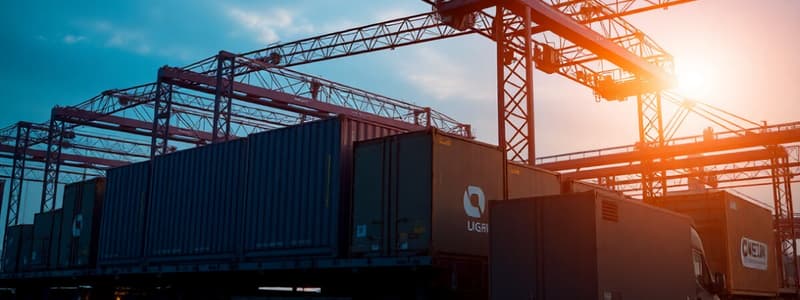Podcast
Questions and Answers
What are the three primary flows in a supply chain?
What are the three primary flows in a supply chain?
- Information, product, funds (correct)
- Materials, labor, capital
- Production, distribution, consumption
- Orders, invoices, payments
Strategic supply chain decisions typically involve short-term order processing.
Strategic supply chain decisions typically involve short-term order processing.
False (B)
What is the main goal of achieving 'strategic fit' in supply chain management?
What is the main goal of achieving 'strategic fit' in supply chain management?
aligning supply chain capabilities with product and market characteristics
The push/pull view categorizes supply chain processes based on whether they _______ or react to customer demand.
The push/pull view categorizes supply chain processes based on whether they _______ or react to customer demand.
Match the following supply chain drivers with their descriptions:
Match the following supply chain drivers with their descriptions:
Which of the following is NOT a key driver of supply chain performance?
Which of the following is NOT a key driver of supply chain performance?
Omni-channel retailing involves separating online and offline sales channels.
Omni-channel retailing involves separating online and offline sales channels.
What is a primary challenge when designing global supply chain networks?
What is a primary challenge when designing global supply chain networks?
Which of the following best describes the focus of strategic decisions in a supply chain?
Which of the following best describes the focus of strategic decisions in a supply chain?
Operational decisions typically involve determining production levels for the next year.
Operational decisions typically involve determining production levels for the next year.
Name two key metrics used to measure forecast accuracy.
Name two key metrics used to measure forecast accuracy.
Aggregate planning involves balancing supply and demand over the ______ term.
Aggregate planning involves balancing supply and demand over the ______ term.
Match the decision type with its corresponding time horizon:
Match the decision type with its corresponding time horizon:
Which of these is a key trade-off considered in aggregate planning?
Which of these is a key trade-off considered in aggregate planning?
Linear programming models are typically used to optimize production plans within spreadsheets like Microsoft Excel.
Linear programming models are typically used to optimize production plans within spreadsheets like Microsoft Excel.
What is the primary purpose of aggregate planning?
What is the primary purpose of aggregate planning?
Which company is known for using a responsive supply chain to quickly introduce new fashion products?
Which company is known for using a responsive supply chain to quickly introduce new fashion products?
Centralizing facilities generally improves responsiveness to regional markets.
Centralizing facilities generally improves responsiveness to regional markets.
What is the trade-off when maintaining high inventory levels?
What is the trade-off when maintaining high inventory levels?
A _____ system reduces inventory costs but risks stockouts during demand surges.
A _____ system reduces inventory costs but risks stockouts during demand surges.
Match the following companies with their described supply chain strategies:
Match the following companies with their described supply chain strategies:
What is a potential downside to decentralizing facilities in a supply chain?
What is a potential downside to decentralizing facilities in a supply chain?
Visual tools in supply chain management are used to obscure complex information.
Visual tools in supply chain management are used to obscure complex information.
Which Excel models are commonly used for hands-on learning in supply chain decisions?
Which Excel models are commonly used for hands-on learning in supply chain decisions?
Flashcards
Forecast Error
Forecast Error
The difference between actual and forecasted demand, used to assess the accuracy of demand predictions.
Mean Absolute Deviation (MAD)
Mean Absolute Deviation (MAD)
A measure of forecast accuracy, calculated as the average absolute difference between actual and forecasted demand.
Mean Absolute Percentage Error (MAPE)
Mean Absolute Percentage Error (MAPE)
A measure of forecast accuracy, calculated as the percentage average of absolute errors.
Aggregate Planning
Aggregate Planning
Signup and view all the flashcards
Trade-offs in Aggregate Planning
Trade-offs in Aggregate Planning
Signup and view all the flashcards
Linear Programming Models
Linear Programming Models
Signup and view all the flashcards
Strategic Decisions
Strategic Decisions
Signup and view all the flashcards
Planning Decisions
Planning Decisions
Signup and view all the flashcards
What is a supply chain?
What is a supply chain?
Signup and view all the flashcards
What are the three main flows in a supply chain?
What are the three main flows in a supply chain?
Signup and view all the flashcards
What is supply chain surplus?
What is supply chain surplus?
Signup and view all the flashcards
What are strategic supply chain decisions?
What are strategic supply chain decisions?
Signup and view all the flashcards
What are planning supply chain decisions?
What are planning supply chain decisions?
Signup and view all the flashcards
What are operational supply chain decisions?
What are operational supply chain decisions?
Signup and view all the flashcards
What is the cycle view of a supply chain?
What is the cycle view of a supply chain?
Signup and view all the flashcards
What is the push/pull view of a supply chain?
What is the push/pull view of a supply chain?
Signup and view all the flashcards
Relating theory to case studies
Relating theory to case studies
Signup and view all the flashcards
Zara's Supply Chain Strategy
Zara's Supply Chain Strategy
Signup and view all the flashcards
Amazon's Supply Chain Integration
Amazon's Supply Chain Integration
Signup and view all the flashcards
Trade-offs in supply chain drivers
Trade-offs in supply chain drivers
Signup and view all the flashcards
Inventory Trade-off
Inventory Trade-off
Signup and view all the flashcards
Facility Location Trade-off
Facility Location Trade-off
Signup and view all the flashcards
Visual tools in supply chain analysis
Visual tools in supply chain analysis
Signup and view all the flashcards
Using Excel for supply chain analysis
Using Excel for supply chain analysis
Signup and view all the flashcards
Study Notes
Supply Chain Management Study Notes
- Supply Chain Definition: All parties involved in fulfilling a customer request (manufacturers, suppliers, transporters, retailers, etc.) encompass information, product, and funds flow.
- Supply Chain Surplus: Customer value minus supply chain costs
- Decision Phases:
- Strategic: Long-term decisions concerning facility location.
- Planning: Mid-term decisions, like inventory policies.
- Operational: Short-term decisions like order processing.
- Supply Chain Views:
- Cycle View: Categorized into cycles like customer order, replenishment, manufacturing, and procurement.
- Push/Pull View: Processes categorized by whether they anticipate or react to customer demand.
- Strategic Fit: Aligning supply chain capabilities with product and market characteristics, focusing on responsiveness vs. efficiency, and strategies for managing uncertainty.
- Key Supply Chain Drivers: Facilities, inventory, transportation, information, sourcing, and pricing.
- Performance Metrics:
- Financial: Profitability, revenue, and costs.
- Operational: Cycle times, fill rates, and inventory turnover.
- Network Design Factors: Factors in designing distribution networks.
- Omni-Channel Retailing: Integrating online and offline channels.
- Network Design Decisions: Facility location, capacity planning, and transportation strategies.
- Global Supply Chain Networks: Globalization Impacts, Risk management, Decision trees, Offshoring vs. onshoring, and flexibility in uncertain markets.
- Demand Forecasting Methods: Qualitative (e.g., market surveys) and Quantitative (e.g., time series analysis).
- Key Forecasting Metrics: Forecast accuracy and error measurement (e.g., MAD, MAPE).
- Aggregate Planning: Balancing supply and demand over the medium term, considering trade-offs like inventory levels, workforce, and production rates.
- Tips for Preparation: Understanding the relationships between strategic, planning, and operational decisions. Applying theoretical concepts to case studies. Focusing on key relationships and trade-offs in supply chain drivers, using numerical examples, especially forecasting and aggregate planning techniques, and using Excel models.
- Critical Thinking and Problem-Solving: Evaluating decisions based on supply chain surplus (customer value - supply chain cost). Relating supply chain management to broader business objectives.
Studying That Suits You
Use AI to generate personalized quizzes and flashcards to suit your learning preferences.



